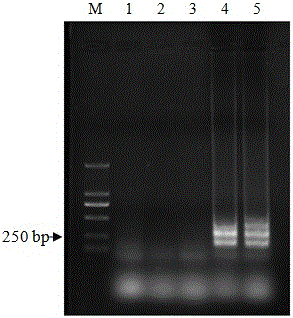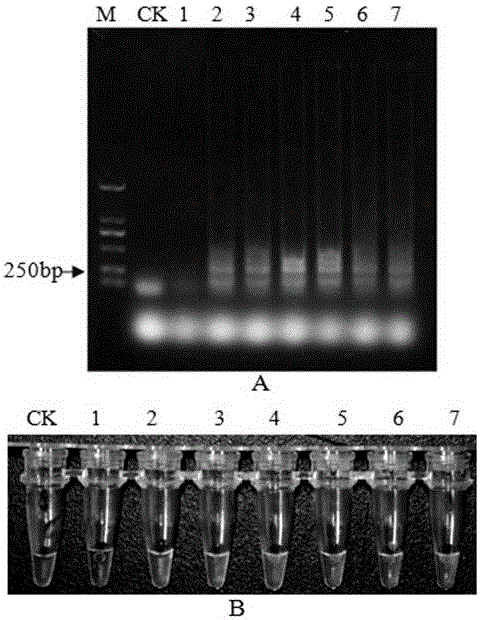LAMP primer group for fast detecting and identifying aphelenchoides ritzemabosi and detection method thereof
A detection method, the technology of chrysanthemum leaves, is applied in the direction of biochemical equipment and methods, recombinant DNA technology, microbial measurement/inspection, etc., which can solve the problems of narrow detection range, complicated technology, high detection cost, etc., and achieve high accuracy and improved High amplification speed and high sensitivity
- Summary
- Abstract
- Description
- Claims
- Application Information
AI Technical Summary
Problems solved by technology
Method used
Image
Examples
Embodiment 1
[0055] Example 1 Design and detection of LAMP primers for Nematode chrysanthemum chrysanthemum
[0056] 1. LAMP primer design
[0057] Download the 18S ribosomal RNA gene sequence of Nematode chrysanthemum chrysanthemum from NCBI (GenBank accession number: EU186067.1). Through sequence comparison and downloading of multiple similar 18S ribosomal RNA gene sequences of other nematodes, multiple alignments were used to find specific sequence fragments in the 18S sequence fragments, and multiple sets of LAMP primer sets for the detection of Nematode chrysanthemum were designed and obtained. Each includes a pair of outer primers, a pair of inner primers and a loop primer.
[0058] After preliminary detection and verification (the method is as follows), a set of optimal LAMP primers was finally screened, and its sequence is as follows:
[0059] Outer primer pair:
[0060] F3 (shown in SEQ ID NO.1): 5'-TGTTGAACCGTTCGGGGT-3'
[0061] B3 (shown in SEQ ID NO.2): 5'-TGTTTCAGCCGACAAAA...
Embodiment 2
[0080] Example 2 Specificity and Stability Detection of LAMP Primers of Nematode chrysanthemum Nematode chrysanthemum
[0081] 1. Sample Preparation
[0082] The chrysanthemum leaf nematodes preserved in our laboratory were used as the test target nematodes, and the banana perforator nematodes, pine wood nematodes, rice root nematodes, root-knot nematodes and incognita isolated from our laboratory were used as controls. nematode, testing the specificity of the LAMP primers for Nematode chrysanthemum.
[0083] The stability of LAMP-specific primers for Nematode chrysanthemum was tested by using the populations of Nematode chrysanthemum cultured under different conditions, single female adult, single male adult, single larva and single egg preserved in our laboratory.
[0084] The extraction of a single worm DNA template, and the LAMP amplification reaction system and reaction conditions are the same as in Example 1, and the results are detected by electrophoresis and fluoresce...
Embodiment 3
[0091] Example 3 Sensitivity detection of LAMP primers for Nematode chrysanthemum
[0092] 1. Sample preparation and detection method
[0093] Adopt the method for embodiment 1 to extract the single worm DNA of chrysanthemum leaf blight nematode, DNA concentration is pressed 10 0 、10 -1 、10 -2 、10 -3 、10 -4 and 10 -5 The gradient dilution was used as a template, and the LAMP primer set in Example 1 was used to perform LAMP amplification according to the reaction system and reaction conditions in Example 1, and each treatment was repeated three times. The LAMP amplification products were detected by the above-mentioned electrophoresis method and fluorescent dye method, respectively.
[0094] 2. Test results
[0095] The LAMP amplification reaction was carried out using the DNA of a single nematode chrysanthemum chrysanthemum nematode in gradient dilution as a template, and the products after the reaction were subjected to electrophoresis and fluorescent dye detection res...
PUM
 Login to View More
Login to View More Abstract
Description
Claims
Application Information
 Login to View More
Login to View More - R&D
- Intellectual Property
- Life Sciences
- Materials
- Tech Scout
- Unparalleled Data Quality
- Higher Quality Content
- 60% Fewer Hallucinations
Browse by: Latest US Patents, China's latest patents, Technical Efficacy Thesaurus, Application Domain, Technology Topic, Popular Technical Reports.
© 2025 PatSnap. All rights reserved.Legal|Privacy policy|Modern Slavery Act Transparency Statement|Sitemap|About US| Contact US: help@patsnap.com



